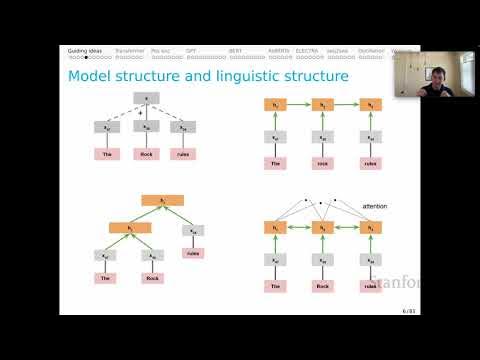Research Overview: Representation Surgery
Summary
TLDRThe presentation on "Representation Surgery: The Theory and Practice of Aine Steering" by Shashu Singh explores how language models generate contextual representations for predicting the next token. It introduces the concept of guardedness, which prevents classifiers from identifying sensitive attributes like gender in these representations. The authors propose an optimization method to minimize changes between vectors while ensuring they adhere to desired distributions, facilitating debiasing and controlled generation without requiring gradients. Experimental results demonstrate the effectiveness of this approach in both reducing gender bias in profession classification and controlling toxicity in generated sentences.
Takeaways
- 😀 The work focuses on representation surgery in language models, emphasizing debiasing and control of text generation.
- 😀 Language models generate contextual representations to predict the next token, which can be treated as well-behaved spaces.
- 😀 'Guardedness' is defined as the inability to classify certain attributes (like gender) from model representations.
- 😀 The paper introduces the concept of an 'aine transformation' to modify model outputs while maintaining semantic coherence.
- 😀 The objective is to minimize the changes made to model outputs while aligning them with desired properties (e.g., non-toxic language).
- 😀 Existing methods often lack theoretical justification, but the proposed method provides a systematic approach to control generation.
- 😀 The proposed optimization framework aims to match the first and second moments of two distributions to ensure minimal changes.
- 😀 The approach uses classification datasets to guide interventions without requiring extensive training or gradient calculations.
- 😀 Experiments demonstrate the effectiveness of the method in removing biases (e.g., gender) while maintaining classification accuracy.
- 😀 The methodology offers a cost-effective alternative for controlling text generation compared to traditional fine-tuning methods.
Q & A
What is the main focus of the work presented by Shashu Singh?
-The work focuses on representation surgery in language models, specifically on how to control and debias the generation of outputs by exploiting the properties of contextual representations.
What is the definition of 'guardedness' in the context of this research?
-Guardedness refers to the inability to classify a control attribute (Z) based on the representations generated by the language model. For example, if gender is a guarded attribute, the model's representations should not reveal the gender of nouns.
What is an 'AINE transformation' as described in the presentation?
-An AINE transformation is a mathematical transformation of the form WX + B, where W and B are learned parameters that ensure the representations from input X are guarded concerning a specific attribute Z.
Why is it important to minimize changes when modifying the output vectors?
-Minimizing changes is crucial to preserving the semantics unrelated to the attribute being controlled, ensuring that the output remains coherent while adhering to the desired properties.
How does the proposed optimization objective work?
-The optimization objective is a constraint optimization problem aiming to minimize the difference between the original and the intervened vectors while ensuring the mean of two distributions (toxic and non-toxic) becomes the same.
What are the first and second moments, and why are they important in this context?
-The first moment refers to the mean of a distribution, while the second moment refers to its covariance. Matching both moments allows for a more effective transformation, ensuring the two distributions resemble each other more closely.
What method was used to evaluate the toxicity of generated sentences?
-The researchers used the Perspective API to assess the toxicity of sentences, generating multiple sentences per prompt and applying interventions based on the toxicity evaluations.
What distinguishes the proposed method from traditional fine-tuning approaches?
-The proposed method does not require gradient calculations or extensive fine-tuning, making it a more efficient and cost-effective way to control generation and debias outputs from language models.
What results did the experiments yield regarding gender guarding and multi-class classification?
-The experiments demonstrated that the proposed method could effectively guard against gender biases without negatively affecting the accuracy of multi-class classification tasks.
What insights does the research provide about the representation of attributes in language models?
-The research indicates that attributes such as toxicity and gender are already encoded in a structured manner within the language model's representations, allowing for effective control and debiasing using global statistics.
Outlines

This section is available to paid users only. Please upgrade to access this part.
Upgrade NowMindmap

This section is available to paid users only. Please upgrade to access this part.
Upgrade NowKeywords

This section is available to paid users only. Please upgrade to access this part.
Upgrade NowHighlights

This section is available to paid users only. Please upgrade to access this part.
Upgrade NowTranscripts

This section is available to paid users only. Please upgrade to access this part.
Upgrade NowBrowse More Related Video

Attention is all you need

Stanford XCS224U: NLU I Contextual Word Representations, Part 1: Guiding Ideas I Spring 2023

Methodology of Singapore Math Part 1

Stuart Hall Representation Theory Explained - This Is Why Representation Theory Matters

DPI-681 Class 1 - Introduction to Large Language Models

Transformers: Η Τεχνολογία Πίσω από το ChatGPT [Μάθε πως Μαθαίνουν]
5.0 / 5 (0 votes)